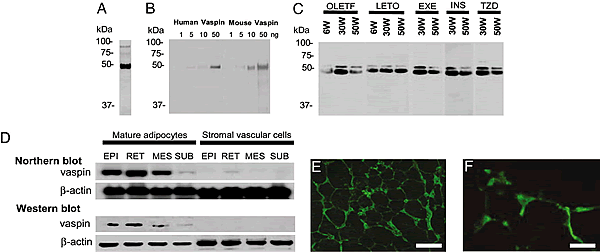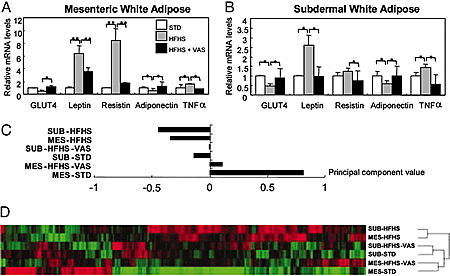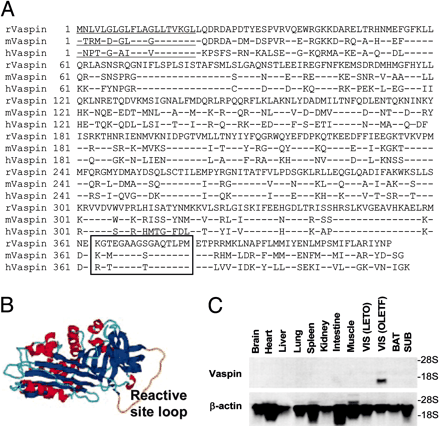
Expression of vaspin in 293T cells, adipocytes, and stromal vascular cells. (A) Western blot analysis of mouse vaspin by using supernatants of 293T cultured cells transfected with AxCAmOL64 and polyclonal antivaspin Ab. A prominent band of ~45 kDa is observed. (B) Western blots of purified recombinant human and mouse vaspins, derived from E. coli by using pET expression system. (C) Western blot analyses of vaspin by using sera of OLETF and LETO rats, and OLETF rats with EXE, OLETF rats administered TZD and insulin (INS). A major ~45-kDa band and a minor ~50-kDa band are seen at 30 wk. Band intensity is notably less at 50 wk in OLTEF rats, but it seems to be normalized with insulin and TZD treatments. (D) Expression of vaspin in mature adipocytes and stromal vascular cells isolated from epidydimal (EPI), retroperitoneal (RET), MES, and SUB WATs as analyzed by Northern and Western blot analyses. Expression is confined to adipocytes of visceral WATs and not to stromal endothelial or vascular cells. (E and F) Expression in the adipocytes was confirmed by immunofluorescence microscopy in 30-wk-old OLETF rats. (Scale bars: E, 100 µm; F, 25 µm.).
Hida K, et al. Proc Natl Acad Sci U S A. 2005 Jul 26;102(30):10610-5

Effect of vaspin on leptin, resistin, TNF, GLUT4, and adiponectin in obese ICR mice fed with HFHS chow. Vaspin administration reverses gene expression profile of WATs. (A and B) Injection of rhVaspin suppressed gene expression of leptin, resistin, and TNF and increased the expression of glucose transporter-4 and adiponectin in obese ICR mice with HFHS chow. Data are mean ± SEM (n = 5). *, P < 0.05; **, P < 0.01. (C) Principal component analysis showing that the HFHS-chow-induced gene expression profile in MES and SUB fats is distinct from that of ICR mice with STD chow and after injection of rhVaspin (VAS). (D) Hierarchical clustering analysis seems to divide in two distinct groups, HFHS and STD chow groups. Both the MES and the SUB gene expression profile in rhVaspin-treated ICR mice fed with HFHS chow is on the same branch as mice fed STD chow.
Hida K, et al. Proc Natl Acad Sci U S A. 2005 Jul 26;102(30):10610-5



Social Network Confirmation